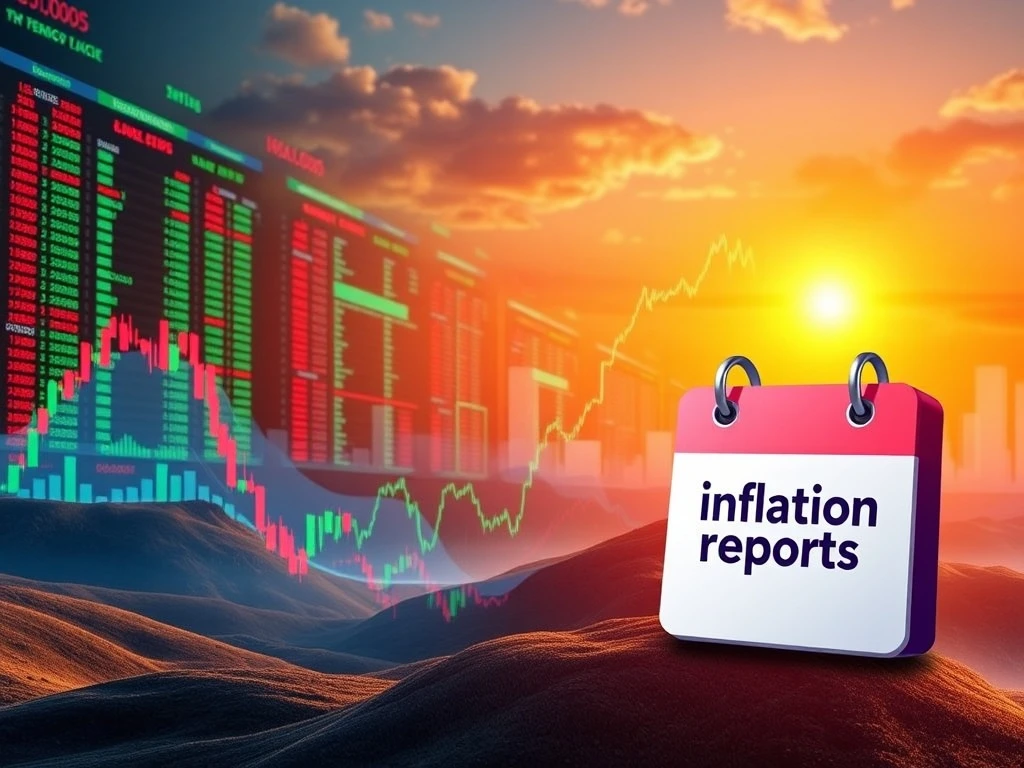Investors closely monitor market movements. Currently, U.S. stock futures indicate a slight upward trend. This cautious optimism comes just before several critical inflation reports this week. Business owners and entrepreneurs, in particular, should pay attention. These reports will significantly influence Federal Reserve policy. They will also impact broader economic conditions. Understanding these dynamics is crucial for strategic financial planning. Consequently, market participants are bracing for potential shifts. The upcoming data could shape investment decisions for months to come.
U.S. Stock Futures Show Cautious Optimism
Early trading suggests a positive sentiment. U.S. stock futures, including those for the Dow, S&P 500, and Nasdaq, are inching higher. This modest rise reflects investor hope. Many hope for inflation data that does not exceed expectations. A cooler inflation reading could signal a more dovish stance from the Federal Reserve. Furthermore, this scenario might lead to lower interest rates sooner. Lower rates generally boost corporate profits. They also make borrowing cheaper for consumers and businesses. Therefore, market participants watch every data point closely. They seek clues about the economic path ahead.
Several factors contribute to this cautious optimism. For instance, recent corporate earnings reports have been mixed but generally resilient. This suggests that companies are adapting to current economic challenges. Additionally, global economic indicators show some stability. This provides a supportive backdrop for equity markets. However, the primary focus remains on domestic inflation figures. These figures hold the key to the Fed’s next moves. Investors are positioning their portfolios accordingly. They aim to capitalize on any positive news while mitigating risks.
Understanding Key Inflation Reports
This week features crucial economic releases. Each report offers a unique perspective on inflation. Investors analyze them to gauge price pressures across the economy. Understanding these reports is vital for predicting market reactions.
- Consumer Price Index (CPI): This is perhaps the most watched inflation gauge. It measures the average change over time in the prices paid by urban consumers. This includes a basket of consumer goods and services. A lower-than-expected CPI could ease concerns about persistent inflation. Conversely, a higher CPI might trigger market apprehension.
- Producer Price Index (PPI): The PPI tracks the average change in selling prices. These are received by domestic producers for their output. It reflects inflationary pressures at the wholesale level. Increases in PPI often precede increases in CPI. Therefore, it offers an early warning sign for consumer inflation.
- Personal Consumption Expenditures (PCE) Price Index: The Federal Reserve prefers the PCE as its primary inflation measure. It provides a comprehensive view of consumer spending. PCE often differs from CPI due to methodology and scope. A stable PCE reading reinforces the Fed’s confidence in its inflation targets.
Each of these reports offers distinct insights. Collectively, they paint a detailed picture of the inflationary environment. Traders and analysts meticulously examine their components. They look for underlying trends and potential surprises. Their findings directly influence the trajectory of U.S. stock futures and broader markets.
The Impact of Economic Data on U.S. Stock Futures
Economic data profoundly influences market sentiment. Specifically, inflation reports directly affect monetary policy. The Federal Reserve uses these figures to guide its interest rate decisions. Higher inflation typically prompts the Fed to raise rates. This action aims to cool down the economy. Conversely, falling inflation might encourage rate cuts. These cuts stimulate economic activity. Therefore, the upcoming reports are pivotal. They could determine the timing and magnitude of future rate adjustments. This directly impacts the outlook for U.S. stock futures.
Interest rates have a broad impact. Higher rates increase borrowing costs for businesses. This can reduce corporate profits. They also make bonds more attractive compared to stocks. Lower rates, conversely, reduce borrowing costs. They can boost corporate investment and consumer spending. Moreover, the yield on Treasury bonds often reacts strongly to inflation data. Bond yields compete with equity returns. Thus, a rise in bond yields can make stocks less appealing. Investors carefully weigh these factors. They adjust their positions based on the latest economic signals. Their collective actions then move the U.S. stock futures market.
Navigating Market Volatility
Market volatility often increases around major economic announcements. Investors should prepare for potential swings. A diversified portfolio remains a sound strategy. This approach helps mitigate risks associated with sudden market shifts. Furthermore, focusing on long-term investment goals is advisable. Short-term fluctuations can be distracting. However, they rarely derail a well-planned long-term strategy.
Staying informed is also crucial. Regularly check reputable financial news sources. Understand the implications of economic data. Avoid making impulsive decisions based on headlines alone. Instead, evaluate the broader context. Consider how current events align with your investment objectives. Patience and discipline are key during periods of uncertainty. These qualities help investors navigate challenging market conditions successfully. They allow for thoughtful responses rather than reactive ones.
Broader Economic Implications for U.S. Stock Futures
The outcomes of this week’s inflation reports carry significant weight. They will shape the narrative for the broader economy. A surprisingly high inflation reading could reignite fears of aggressive Fed tightening. This might lead to a slowdown in economic growth. Conversely, a benign inflation report could bolster confidence. It could suggest a soft landing for the economy. This scenario would support continued growth. Consequently, it would likely provide a further boost to U.S. stock futures.
Different sectors will react differently. For example, technology and growth stocks are often sensitive to interest rates. Higher rates can hurt their future earnings valuations. Value stocks, conversely, may be more resilient. They often benefit from stable economic conditions. Energy and materials sectors might react to commodity price changes. These changes are often linked to inflation expectations. Therefore, investors should consider sector-specific impacts. They need to understand how their holdings might perform under various inflation scenarios. This nuanced understanding enhances investment decisions. It helps optimize portfolios for future economic conditions.
Global economic factors also play a role. International trade tensions, geopolitical events, and currency fluctuations can influence domestic markets. While the primary focus is on U.S. inflation, external pressures always exist. For instance, supply chain disruptions from overseas can impact domestic prices. Strong economic performance abroad can also boost demand for U.S. exports. This, in turn, supports corporate earnings. Therefore, a holistic view is essential. It helps investors grasp the full picture. This comprehensive understanding aids in making informed decisions about U.S. stock futures and other assets.
In conclusion, the week ahead is critical for financial markets. U.S. stock futures reflect a cautious yet hopeful stance. The upcoming inflation reports will provide vital clarity. These reports will guide the Federal Reserve’s policy decisions. They will also influence investor sentiment. Staying informed and maintaining a disciplined approach remains paramount. Investors must be prepared for potential volatility. However, they should also recognize opportunities. The market continues to adapt. Its direction will largely depend on the incoming economic data. Prudent planning will help navigate these dynamic conditions effectively.
Frequently Asked Questions (FAQs)
What are U.S. stock futures?
U.S. stock futures are agreements to buy or sell a specific stock index at a predetermined price on a future date. They allow investors to speculate on the future direction of the stock market. Futures contracts trade nearly 24 hours a day. They provide an early indication of how the stock market might open. They also reflect sentiment outside regular trading hours.
Why are inflation reports important for stock markets?
Inflation reports are crucial because they influence the Federal Reserve’s monetary policy. High inflation often leads to interest rate hikes. These can slow economic growth and reduce corporate profits. Low inflation might encourage rate cuts, stimulating the economy. Therefore, these reports directly impact corporate earnings and investor sentiment, moving stock prices.
How does the Federal Reserve use inflation data?
The Federal Reserve uses inflation data, particularly the PCE Price Index, to guide its decisions on interest rates. Its dual mandate includes maximizing employment and maintaining price stability (low and stable inflation). If inflation is too high, the Fed may raise rates to cool the economy. If inflation is too low, it might lower rates to stimulate growth.
What is the difference between CPI, PPI, and PCE?
The Consumer Price Index (CPI) measures prices paid by consumers for goods and services. The Producer Price Index (PPI) tracks prices received by domestic producers for their output. The Personal Consumption Expenditures (PCE) Price Index measures consumer spending across a broader range of goods and services. The Fed prefers PCE because it accounts for changes in consumer behavior and is less volatile.
How can investors prepare for inflation report volatility?
Investors can prepare by diversifying their portfolios across different asset classes. They should also consider investments that historically perform well during inflationary periods, such as real estate or commodities. Maintaining a long-term investment perspective helps. Avoiding emotional, knee-jerk reactions to short-term market swings is also beneficial. Regularly reviewing financial news and understanding the economic context is vital.
























